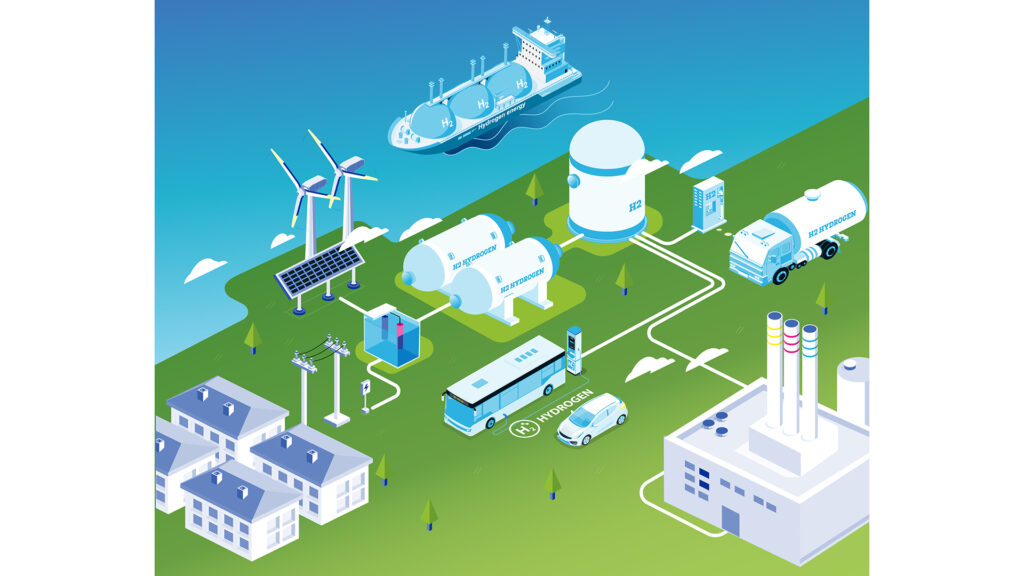Mirela Athanasiou, Head of Operations and Communications at the Clean Hydrogen Partnership, talks about Hydrogen Valley and how it is accelerating Europe’s clean hydrogen economy.
Europe’s clean hydrogen transition has reached a decisive turning point, with the focus shifting to large-scale deployment. The most visible example of this change is the rise of hydrogen valleys, regional ecosystems where hydrogen is produced, stored, distributed and used across multiple sectors. Europe’s energy revolution is currently happening in regions, cities and industrial clusters, building clean hydrogen economies from the ground up to drive decarbonization and regional growth.
From concept to reality
Born out of early work with the Clean Hydrogen Partnership and its predecessor region, Hydrogen Valley integrates the entire hydrogen value chain within one region, from renewable energy production to industrial use and mobility.
Hydrogen Valley brings together Europe’s strengths in research excellence, regional cohesion and industrial innovation. They demonstrate that decarbonization can simultaneously promote competitiveness, jobs and energy security. That is why the REPowerEU plan puts hydrogen valleys at the center of Europe’s hydrogen strategy and allocates €200 million to double the number of hydrogen valleys by 2025.
Europe is already a world leader, with around 60 hydrogen valleys developed or operating across the continent, worth €150 billion in investments. Of these, more than 20 valleys have benefited from the Clean Hydrogen Partnership’s support, mobilizing over €1.3 billion in investments.
From Groningen to Galicia, from Crete to North Sea ports, regional ecosystems are emerging where hydrogen is produced, stored, distributed and used locally.
The Hydrogen Valleys supported by the Clean Hydrogen Partnership vary in size and geography, from major industrial hubs to projects focused on island transportation. Large-scale projects such as NAHV (northern Italy, Slovenia, Croatia) and BalticSeaH2 (southern Finland, Estonia) aim to produce more than 4,000 tons of hydrogen per year. Small-scale valleys such as Mallorca’s Green Highlands and Portugal’s H2tALENT demonstrate the viability of hydrogen in island and distributed environments, highlighting the flexibility of the model and its application across diverse end-uses, from industry to transportation.
The valley also increases society’s trust and awareness of technology. Citizens will be able to see hydrogen vehicles on their roads, and industry will be able to expand and connect dedicated infrastructure for production and transportation, and form cross-sector collaborations. Investors can value real assets, and policymakers can watch their strategies become reality.
promote, stimulate, accelerate
Regions and cities hold the key to hydrogen deployment. Plan transport vehicles, manage industrial zones, and oversee permits. However, many companies lack the expertise or financing capacity to turn their plans into profitable projects.
To fill this gap, the Clean Hydrogen Partnership created the Project Development Assistance (PDA) initiative. The new Hydrogen Valley facility will build on the success of the regional pilot and provide tailored technical, financial and legal advice to help promoters reach a final investment decision (FID).
Two support tracks are provided.
PDA Light (6 weeks) is for early-stage concepts with pre-feasibility adjustments. PDA Plus (12 weeks) for advanced projects close to FID.
In 2025, 15 valleys from 11 countries were selected for support. This is evidence of a growing appetite for practical project development support in Europe.
Knowledge sharing for acceleration
Alongside this facility, the Hydrogen Valleys Knowledge Center provides a repository of best practices, case studies, and templates covering governance, permitting, financing, and stakeholder engagement. Its mission is to make replication faster and cheaper, and to help new valleys build on proven experience. It also facilitates peer-to-peer learning that brings together policy makers, researchers, and industry leaders.
About the Clean Hydrogen Partnership
The Clean Hydrogen Partnership is an EU public-private partnership that supports research and innovation to accelerate the development and deployment of clean hydrogen technologies in Europe.
About H2V facilities
The H2V Facility, funded by the Clean Hydrogen Partnership, aims to accelerate the promotion of hydrogen valleys towards FID and support the European Commission’s goal of 50 hydrogen valleys operating or under construction in the EU by 2030.
Over the next five years, the H2V Facility will provide dedicated non-financial support through three pillars: 1) Project Development Assistance (PDA), 2) H2V Knowledge Center, and 3) H2V Platform.
Project development support supports Hydrogen Valley from idea to concept (PDA Lite), concept to feasibility, and finally FID (PDA Plus). The H2V Knowledge Center serves as a self-service and interaction platform for the broader hydrogen community, providing content, knowledge products, and exchange formats on best practices at various project maturity levels. The H2V platform featuring Hydrogen Valley will be enhanced with new technology and content capabilities to address the evolving needs of Hydrogen Valley.
This article will also be published in the quarterly magazine issue 24.
Source link

